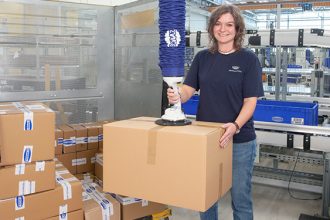
This post is part of the EASE Educational Series: Ergonomic Solutions from Head to Toe
Research from the Bureau of Labor Statistics finds that 330 general warehousing and storage workers experienced an eye injury that kept them out of work for multiple days in 2019. Further, according to the University of Wisconsin’s Department of Ophthalmology and Visual Sciences, workplace eye injuries — including trauma that may cause permanent damage (such as vision loss or blindness), as well as eye strain — account for more than $300 million in lost productivity, treatment and compensation annually.
Obviously, wearing safety eye protection made of glass, plastic, or polycarbonate — such as safety glasses with side shields, face shields, or goggles — will significantly reduce the severity of an eye injury caused by flying objects, airborne particles, chemicals, tools, or other hazards. Assuming that the safety eyewear both fits and is worn properly, wearing this personal protective equipment (PPE) can prevent up to 90% of eye injuries.
While less traumatic physically, excessive or prolonged eye strain can be equally detrimental to the health of workers, causing fatigue, blurred vision, headaches, dry eyes, and more. Fortunately, there are a variety of ergonomic techniques, devices, and solutions that can be put into place to help minimize the risk. These include:
Properly Adjusted Ambient Lighting. Areas where ambient light is too bright or too dim can make it difficult for workers to see properly, resulting in eye strain. Additionally, taking steps to reduce glare but adjusting the distance, height, and angle of a light source to ensure it isn’t shining into personnel’s eyes can reduce eye strain risk.
Correctly Calibrated Monitors and Screens. Similar to ambient lighting, monitors and device screens should be at a correct distance, height, and angle relative to the person using them. They should also be properly calibrated with sufficient contrast, resolution, and brightness to minimize eye strain. Monitors can be mounted to adjustable arms that allow them to be raised, lowered, shifted side-to-side, and/or tilted to best suit the user. Typically, the optimal position aligns the user’s eyes with the top of the screen so they look slightly downward without requiring excessive bending of the neck. As for distance, a standard rule of thumb is that monitors or screens should be 20 to 26 inches away from the user’s face.
Supportive Seating. If a worker is seated at a monitor, the chair should provide enough back support to allow them to sit upright and at a comfortable viewing distance. The user should not be hunched over, nor should their head be tilted excessively up or down in an effort to better see the device, as doing so can cause back and neck injuries.
Train Workers To Rest Their Eyes. It’s important to periodically give the eyes a break. Ophthalmologists often recommend the “20-20-20 Rule.” That is, for every 20 minutes spent looking at a monitor or screen, shift the eyes to look at an object at least 20 feet away for a minimum of 20 seconds. This allows the eyes to refocus and reduce the risk of eye strain.
Specialized Glasses. Blue-light filtering glasses that minimize the stimulating effects of monitors and screens can be purchased without a prescription. Conversely, prescription eyeglasses can be obtained for use with electronic devices to accommodate specific eye conditions.
Added Moisture. Workers whose eyes are negatively impacted by dry environments can use artificial tears (over the counter or prescription). Adding a humidifier to the immediate workspace might also help. Further, simply encouraging workers to blink more can reduce the phenomenon of dry eye. Normally, humans blink roughly 15 times per minute. Those staring at screens, however, only blink five to seven times per minute, resulting in dryer eyes. Blinking more can help prevent this phenomenon.
Properly Fitted Safety Glasses Worn Correctly. Just outfitting personnel with safety eyewear isn’t enough. To ensure workers will wear their eye PPE, the shields, glasses, or goggles must fit snugly without causing discomfort and without sliding down the nose or face. Workers frustrated by lenses that easily fog up should be equipped with anti-fog sprays, or with safety glasses whose lenses have specific anti-fog coatings. Tinted lenses can also help reduce eye strain for those working in bright environments. For those frequently transitioning from bright to dark areas (such as around dock doors), lenses that automatically adjust their degree of tint can be used to reduce eye strain.
Looking for more ways to improve ergonomics in your manual material handling operation? Download the free publication, “Ergonomic Guidelines for Manual Material Handling,” published by the members of MHI’s Ergonomic Assist Systems & Equipment (EASE) Industry Group.



